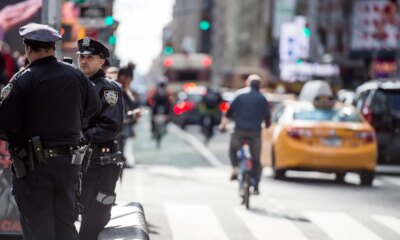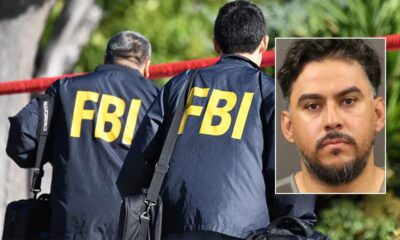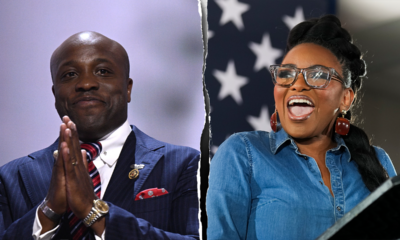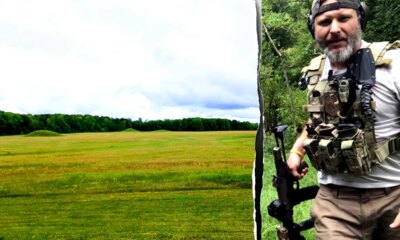Nevada
Forged at Nevada: Vanessa Gutierrez ’16 (molecular microbiology and immunology), ’21 Ph.D. (cellular and molecular biology) | Fall 2025 Issue | Nevada Silver and Blue

When the COVID-19 pandemic struck, the Nevada State Public Health Laboratory was overwhelmed with testing. Vanessa Gutierrez ’16 (molecular microbiology and immunology), ’21 Ph.D. (cellular and molecular biology), then a doctoral student, and her colleagues at the University stepped in. Together, they prepared solutions, rushed supplies and acted as an extra source of support for the state’s front-line testing. “It really emphasized how what we do matters,” Gutierrez said. “We were contributing to society.”
That experience confirmed something Gutierrez had begun to realize in graduate school: science makes its greatest impact when it’s connected to people’s lives. She saw it when her mother lit up after Gutierrez explained the complex process of cell culture. “I told her, ‘Sometimes, when someone has cancer, you can actually use a sample from their body to grow that cancer in a lab and study how it works.’ She immediately understood and thought it was very cool.”
Today, Gutierrez is a postdoctoral researcher at Duke University, studying rare muscle diseases and heart failure — bridging basic biology with clinical applications. “I went from working with viruses, to the immune system, to muscle diseases,” she said. One project she is particularly engaged in explores Barth syndrome, a rare genetic disorder that affects multiple systems of the body.
Her eyes light up when she talks about her work. “I could sit down and talk science forever,” she said.
That spirit of curiosity, nurtured at the University, was shaped by mentors such as Cyprian Rosetto ’09 Ph.D. (cellular and molecular biology), an alumna who was also an associate professor of microbiology and immunology. “Cyprian made me want to pursue science,” Gutierrez said. “She was extremely patient and supportive, and she pushed me to make connections that shaped my career.”
Rossetto describes mentorship as part of a cycle of giving. “I had fantastic mentors who encouraged hands-on research. My motivation now is to foster that same love of science in junior scientists.”
That ethic has become central to Gutierrez’s own approach. At Duke, she mentors younger researchers, including Ph.D. student Gabriella Torres.
“I once told [Gutierrez| I was a visual learner, and the next meeting she had drawn out the pathway we were studying,” Torres said. “It made me realize I wasn’t a bad scientist, I just needed a different way to learn.”
Science itself is one of the clearest examples of the multiplier effect in action. While some discoveries make headlines, they build on decades of smaller discoveries, each one growing from the last. “Every scientific discovery is a breakthrough, no matter the size,” Gutierrez said.
Her journey is proof that even the tiniest ripples grow into waves of progress, expanding knowledge and shaping healthier, more hopeful futures for all.
Discover how Vanesssa’s journey reflects an overarching effort shaping Nevada’s future — and beyond.
Read The Future Rises Here

Nevada
2025 Nevada Preps All-Southern Nevada girls cross country team revealed

First team
Gigi Benoualid, Coronado — The senior finished seventh at the 5A Southern Region meet (19 minutes, 26.3 seconds) and was eighth at the 5A state meet (19:41).
Scarlett Cotrone, Faith Lutheran — The junior finished 11th at the 5A Southern Region meet (19:52.4) and was ninth at the 5A state meet (19:45) to help the Crusaders win the 5A team state title.
Ryen Hughes, Shadow Ridge — The junior finished fourth at the 5A Southern Region meet (19:12.4) and was fifth at the 5A state meet (19:16).
Aislin McMahon, Sky Pointe — The junior finished second at the 5A Southern Region meet (18:54.8) and was second at the 5A state meet (19:00).
Brooke-Lynn Miller, Coronado — The senior won the 5A Southern Region individual title (18:40.8) and was seventh at the 5A state meet (19:19). She is committed to Cal Baptist.
Elynn Okuda, Shadow Ridge — The senior finished sixth at the 5A Southern Region meet (19:16.1) and was third at state (19:11).
Lacy Tippetts, Sky Pointe — The junior finished third at the 5A Southern Region meet (18:58.2) and was 13th at the 5A state meet (19:57).
Sophia Weisz, Faith Lutheran — The junior finished fifth at the 5A Southern Region meet (19:13.1) and was 10th at state (19:45) to help the Crusaders win the 5A team state title.
Coach of the year
Jeff Edwards, Faith Lutheran — Guided the Crusaders to the Class 5A team state title, the program’s fifth overall and first since 2001.
Second team
Jenna Anderson, Faith Lutheran — The sophomore finished 24th at the 5A Southern Region meet (20:34.6) and was 14th at the 5A state meet (19:57) to help the Crusaders win the team title.
Lola Borsh, Desert Oasis — The freshman finished 16th at the 5A Southern Region meet (20:16.5) and was 26th at the 5A state meet (20:26).
Katherine Hodges, Sky Pointe — The junior finished 13th at the 5A Southern Region meet (20:12.8) and was 23rd at the 5A state meet (20:18).
Lacy Mayes, Centennial — The sophomore finished eighth at the 5A Southern Region meet (19:30.6) and was 19th at the 5A state meet (20:05).
Autumn McQuirter, Liberty — The sophomore finished 15th at the 5A Southern Region meet (20:15.7) and was 12th at the 5A state meet (19:54).
Mia Musemici, Desert Oasis — The senior finished 10th at the 5A Southern Region meet (19:47.8) and was 24th at the 5A state meet (20:23).
Belle Parrel, Centennial — The freshman finished ninth at the 5A Southern Region meet (19:47.4) and was 17th at the 5A state meet (20:01).
Michelle Stana, Clark — The freshman won the 4A individual Desert League (21:19.9) and state (20:43.2) titles.
Mackenzie Teel, Sky Pointe — The senior finished 14th at the 5A Southern Region meet (20:15.5) and was 37th at the 5A state meet (20:57).
Julia Vancura, Faith Lutheran — The senior finished 12th at the 5A Southern Region meet (20:01.0) and was 21st at the 5A state meet (20:10).
Honorable mention
Mandi Abney, Shadow Ridge
Savannah Abney, Shadow Ridge
Emma Ansorge, Basic
Maleah Bennett, Centennial
Allison Blazi, Amplus Academy
Kensley Bleak, Lincoln County
Isabella Bustillos-Rivera, Desert Oasis
Ava Dupuis, Palo Verde
Isabelle Franks, Faith Lutheran
Leah Groppenbacher, Arbor View
MJ Gutierrez-Hess, Green Valley
Payton Howse, Clark
Sadie Ivins, Lincoln County
Madeline Labay, Bishop Gorman
Aubrei Lay, Sky Pointe
Selina Leipard, Clark
Ava Levy, Palo Verde
Stella Lin, Coronado
Mackenzie McClain, Sky Pointe
Adalyn Mosley, Foothill
Yalitzi Muro, Western
Elizabeth Neumann, Silverado
Julianna Ondrisko, Pahrump Valley
Sophie Romero, Pahrump Valley
Isabelle Searer, Liberty
Avery Stanton, Coronado
Eliott Stepanek, Faith Lutheran
Amira Turner, Centennial
Isla Ulmer, Coronado
Olivia Wheeler, Sky Pointe
Contact Alex Wright at awright@reviewjournal.com. Follow @AlexWright1028 on X.
Nevada
Justice Dept. sues Nevada over voter rolls

LAS VEGAS (KTNV) — The Justice Department on Friday sued Nevada and three other states, claiming they’d failed to provide requested voter roll information.
Nevada officials, however, said the federal government hasn’t answered basic questions about how the information would be kept secure and questioned why officials wanted the data.
WATCH | What to know about the lawsuit
Justice Dept. sues Nevada over voter rolls
The 10-page lawsuit, filed in federal District Court in Nevada, says the government is seeking the information to enforce the provisions of the National Voter Registration Act, the Help America Vote Act and the Civil Rights Act.
It says the Justice Department asked the state on June 25 for information including a copy of its computerized statewide voter registration list. It said the information could be sent via encrypted email or by using the department’s secure file-sharing system.
The state immediately replied, sending a copy of the voter registration list, including names, addresses and birthdates, but not drivers license information or the last four digits of Social Security numbers.
The department responded on Aug. 14, again asking for the full database and adding “the purpose of the request is to ascertain Nevada’s compliance with the list maintenance requirements of” federal election laws.
The state, according to the lawsuit, wrote back to say the federal government had no basis for the request and claimed it was concerned about privacy of voter data.
The lawsuit asks the court to declare Nevada’s refusal to provide the entire database unlawful, and order the state to turn it over.
In response, Nevada Secretary of State Cisco Aguilar said in a statement Friday that the state’s concerns have gone unaddressed.
“The Department of Justice is making sweeping demands of states to hand over private voter data. Despite our simple requests for information on how they’re going to keep this data secure, they’ve given us no clear answers,” Aguilar said in the statement. “It’s my duty to follow Nevada law and protect the best interests of Nevadans, which includes protecting their sensitive information and access to the ballot.
“While these requests may seem like normal oversight, the federal government is using its power to try to intimidate states and influence how states administer elections ahead of the 2026 cycle. The Constitution makes it clear: elections are run by the states. Nevada will continue to run safe, secure and accessible elections and I’ll always stand up for the rights of our voters.”
In an interview on Friday, Nevada’s senior U.S. Sen. Catherine Cortez Masto questioned the motives of the Justice Department.
KTNV
“You’ve got to question why DOJ is asking for this information and why they’re pushing for this information,” she said. “Is it really to protect voting rights across this country, or is there some other nefarious purpose?”
Added Cortez Masto: “What I have seen is a focus on immigration, right? And their idea of purging all undocumented individuals from this country, including DREAMers, including those that are married to U.S. citizens, including those that are not violent criminals. We have seen that they are continuing down this path, and they are trying to figure out how to gather as much data as they can to use it against individuals in this country.”
President Donald Trump has falsely asserted that he won the 2020 election, nationwide and in Nevada, where Joe Biden defeated Trump by 2.39 percentage points or 33,596 votes statewide.
Six Republican electors were later indicted for sending false Electoral College certificates to Washington, D.C., part of a nationwide plot to keep Trump in office. The case was challenged on a technical issue, but the Nevada Supreme Court upheld the charges, and a trial is expected in the new year.
An email seeking comment from the attorney general’s office — which will defend Nevada in court — was not immediately returned Friday.
Do you have a question about politics in Nevada? Ask Steve Sebelius by emailing Steve.Sebelius@ktnv.com.

Nevada
Nevada nonprofit, BCP challenging PUCN over NV Energy’s daily demand charge

LAS VEGAS (KTNV) — A Nevada nonprofit organization and the Attorney General’s Bureau of Consumer Protection are challenging the Public Utilities Commission of Nevada in court after the organization approved new NV Energy policies.
Vote Solar is a nonprofit advocacy group that focuses on state policies affecting solar and clean energy solutions.
WATCH | Darcy Spears breaks down challenge against PUCN
Nevada nonprofit, BCP challenging PUCN over NV Energy’s daily demand charge
According to their petition for judicial review, they are questioning the PUCN’s decision to approve two separate policies:
- A new daily demand charge for residential and small business customers in Southern Nevada
- A new 15-minute net metering policy for rooftop solar customers in Northern Nevada
In the petition, Vote Solar officials claim the PUCN’s final decisions are:
- In violation of constitutional or statutory provisions
- In excess of the statutory authority of the Commission
- Made upon unlawful procedure
- Affected by other error of law
- Clearly erroneous in view of the reliable, probative and substantial evidence on the record
- Arbitrary or capricious or characterized by abuse of discretion
“The PUCN’s decision is a major step backward for Nevada’s clean energy future,” said Chauntille Roberts, Regional Director at Vote Solar. “Nevada deserves energy policies that protect consumers, expand access to solar, and move our state forward—not backward.”
The Attorney General Office’s Bureau of Consumer Protection has filed a separate petition for judicial review.
“The demand charge rate structure (if permitted to be implemented), the 15-minute NEM netting methodology, and the approved affiliate charges result in rates that are unjust, unreasonable, and unlawful in contravention of NRS 704.040, and undermine the Commission’s fundamental duty under NRS 704.001 to provide utility ratepayers with just and reasonable rates,” the filing states in part.
The filing also states commissioners approved $2.7 million worth of affiliate charges that ratepayers would cover.
“The Commission’s decision concerning affiliate charges is belied by the record as the evidence in this docket demonstrates that NPC failed to provide any evidence, let alone substantial evidence, sufficient to support the recovery of an aggregate of $2.7 million,” the filing states. “Not only is the $2.7 million in affiliate charges unsupported by actual charges, it is also unreasonable and an unsupported monetary number, resulting in the Commission’s decision being arbitrary and capricious.”
No future court hearings have been scheduled for that case, as of Friday morning.
Channel 13 has reached out to NV Energy and the PUCN to see if they would like to comment on the petition.
NV Energy sent the following statement to us.
“NV Energy believes the changes that were approved and reaffirmed by the Public Utilities Commission of Nevada are consistent with state law, and we will be following this filing closely.
The demand charge more accurately captures the cost of energy delivery. It also helps to fix inequities between rooftop solar and non-rooftop solar customers. Because of the current billing structure, rooftop solar customers pay less than non-rooftop solar customers for the cost of service, shifting costs to non-rooftop solar customers.
Between 2018 and 2024, the total cost shift born by non-rooftop solar customers in Southern Nevada is $424 million. The total subsidy in Southern Nevada in 2025 is expected to grow by an additional $80 million, based on expected growth for the rest of the year.
The recently approved demand charge helps fix the inequities caused by the current system, and helps ensure that customer bills more accurately reflect the cost it takes to provide them with service.”
NV Energy Spokesperson
As of the time this article was published, we have not heard back from the PUCN.
In September, the PUCN approved the new rate model, which has sparked controversy among many Southern Nevadans who claim this will make their energy bills continue to go up.
“It’s painful. I just wanted to express concern as a private citizen that corporate America is going to do what it’s going to do to maintain profits and dividends,” Las Vegas local Joel Tauber told us in October.
“Why can a monopoly, a utility monopoly, dictate how I live in my residence,” retiree Jody Rodarmal told us in September. “If you believe there’s not going to be any increase, then why go to a new style of billing?”
SEPTEMBER 2025: NV Energy’s new billing structure sparks concern among Las Vegas residents
NV Energy’s new billing structure sparks concern among Las Vegas residents
How would the daily demand charge work?
According to NV Energy, the daily demand charge will be calculated by taking the highest amount of energy used in a 15-minute period each day and multiplying it by the current kilowatt-per-hour rate.
That charge will then be added to your bill. For the average customer, NV Energy estimates this will amount to roughly $20 per month.
WATCH: Ryan Ketcham explains NV Energy’s new daily demand charge
NV Energy is adding a ‘daily demand charge’ to power bills. What does that mean for consumers?
In past statements to Channel 13, NV Energy officials have stressed the rate increase requests are intended to recoup the costs of projects it undertakes to shore up the power grid.
However, there have been questions about that over the last year after scandals involving overcharging customers and trying to pass on the costs of things like luxury hotels, travel, and liquor to ratepayers, including a $1.2 million tab at Red Rock Resort.
According to NV Energy, Nevada customers already pay a lower average rate than the rest of the country. Through June 2025, the company says its rates were 22% lower than the U.S. average and 60% lower than in California.
Do you have a concern or question about something happening in the valley? Email Darcy.Spears@ktnv.com.
-

 Alaska1 week ago
Alaska1 week agoHowling Mat-Su winds leave thousands without power
-

 Texas1 week ago
Texas1 week agoTexas Tech football vs BYU live updates, start time, TV channel for Big 12 title
-
Ohio1 week ago
Who do the Ohio State Buckeyes hire as the next offensive coordinator?
-

 Washington5 days ago
Washington5 days agoLIVE UPDATES: Mudslide, road closures across Western Washington
-

 Iowa7 days ago
Iowa7 days agoMatt Campbell reportedly bringing longtime Iowa State staffer to Penn State as 1st hire
-

 Miami, FL1 week ago
Miami, FL1 week agoUrban Meyer, Brady Quinn get in heated exchange during Alabama, Notre Dame, Miami CFP discussion
-

 Cleveland, OH7 days ago
Cleveland, OH7 days agoMan shot, killed at downtown Cleveland nightclub: EMS
-
World6 days ago
Chiefs’ offensive line woes deepen as Wanya Morris exits with knee injury against Texans


















